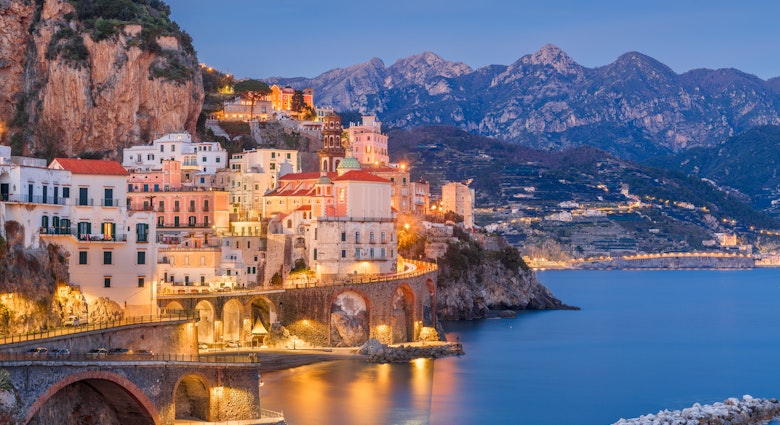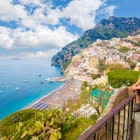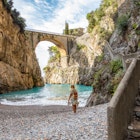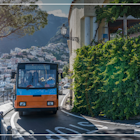The Amalfi Coast, with its chalk-colored towns clinging to the wooded coast, glorious food, fragrant citrus groves and glamorous beaches backed by Italy’s most stunning seacliffs, is one of Italy’s highlights.
However, the downside to these incredible attractions is that everyone is now in on the secret and the local population swells to bursting point at peak times. But each of its seasons has its particular charms, and there are pros and cons to traveling to the Amalfi Coast at different times of the year.
During peak times – including summer and Easter – prices are high and it’s crowded, but there’s a festive atmosphere and tranquility can be found away from the tourist hotspots. If you travel in the low season, the weather can be unpredictable, but prices are lower and the coast feels as if it’s been returned to the locals. With a bit of planning, you can navigate high- or low-season challenges more easily than the bends of its famous coastal road.
July and August are the warmest months on the Amalfi Coast
These are the months to aim for if you want guaranteed high temperatures, sunshine and plenty of beach action. The warmest month is August, with temperatures over 30°C (86°F), but July is not far behind. Expect crowds, heat and traffic: this is when Italy takes its annual summer holiday, international tourist numbers are high, and it will be a struggle to find a space on the small, pebbly beaches to lay down your towel.
The upside is the festive, party atmosphere, streets that are alive and vibrant, and lots of festivals along the coast, including the festival of lemons on the third weekend in July. On the Night of St Lorenzo on the 10th of August, people camp out on the beach to see shooting stars (the Dawn Concert takes place at the Ravello Festival), and on the big Italian summer holiday of Ferragosto (the Assumption of Mary) on the 15th of August, processions are held in various towns, including Positano.
During peak times there are travel restrictions on the famous 23-mile SS163 coastal stretch between Vietri sul Mare and Positano. On weekends from June 15th to September 30th, and for the entirety of Easter week and August, non-resident cars with a license plate ending in an even number cannot drive along the coast on even-numbered days between 10am and 6pm. The same restrictions apply to cars with a license plate ending in an odd number – they cannot travel on odd-numbered days. If you’re planning to drive and aiming for a particular hotel, contact your accommodation to find out their arrangement.

May and October are great for hiking
In May temperatures hover around 20°C (68°F), wildflowers are blooming and the landscape is at its greenest. It’s usually warm enough to wear a t-shirt by day but evenings are much cooler. Mid-May is a great time to visit for some sunshine without the usual crowds.
In early Autumn, temperatures are similar, but the sea is warmer and there are truffles and funghi on the menu. October is a great time to hike along the coast’s many walking trails when it’s sunny without being too hot, and the paths are less busy.
April and November have cooler weather and fewer crowds
April temperatures hover around a cool but often sunny 13°C to 20°C (55°F to 68°F), and wildflowers are blooming in the countryside. This is a good time to visit to avoid big crowds – the only exception is Easter week (March/April), which is very popular and has traffic restrictions along the SS163.
Temperatures in November average 13°C to 18°C (55°F to 64°F) and the sea is warmer than in spring. Towns and villages are quieter and there are fewer ferries, but there’s more of a sense of day-to-day local life during this time. The Festival of Sant' Andrea, Amalfi’s largest religious festival, is celebrated twice a year – once in July and again on the 30th of November.

Early June and September have summer sun but fewer crowds
June and September temperatures are very warm, hovering from around 20°C to 27°C (68°F to 80°F), but the coast begins to get busy in mid-June (when Italian school holidays start) and this high season continues until the end of September.
Early June is a better time to visit than later in the month to avoid the crowds. There are several saint days in Amalfi during June, with processions and food stalls. The sea is warmer in September as it’s had all summer being warmed by the sun. Although the coast is busy in these months, it’s still not as packed as the peak months of July and August.
December to March is the cheapest time to visit the Amalfi Coast
The cheapest time to visit the Amalfi coast is winter. However, the weather is much more unpredictable – you'll often get bright skies but this is when the coast receives the bulk of its rainfall. Bear in mind that local heating systems are often fairly ineffective in this usually warm climate, which can lead to chilly accommodation.
Beach clubs are closed, which gives resorts a somewhat forlorn atmosphere. The exception is Christmas and New Year when there are celebrations, nativity scenes and processions, as well as New Year fireworks along the coast.
Nevertheless, if you seize the chance to go in winter, dress like an onion (layers, layers, layers) and relish the chance to explore the Amalfi Coast in peace without crowds of visitors jostling for space.












